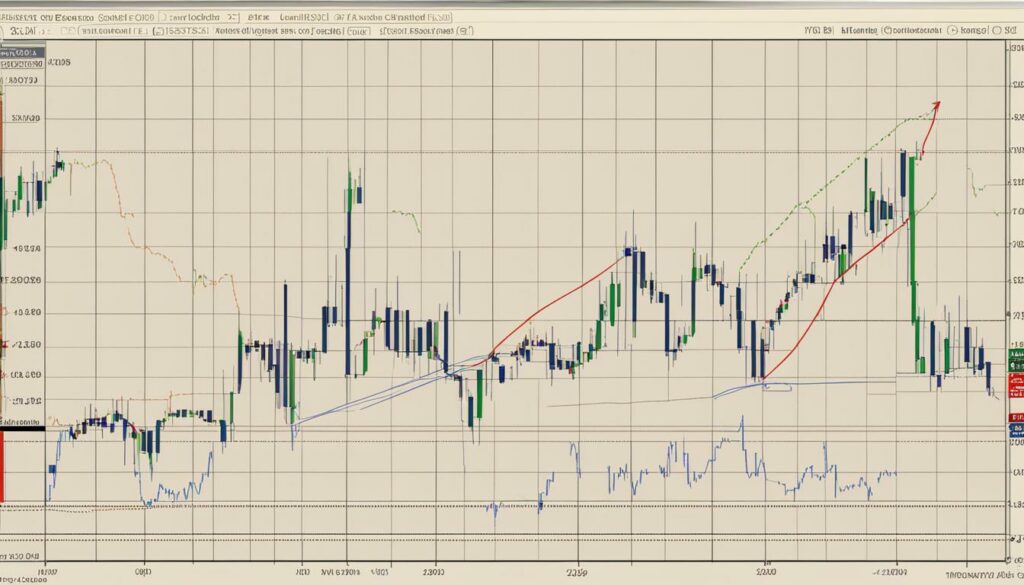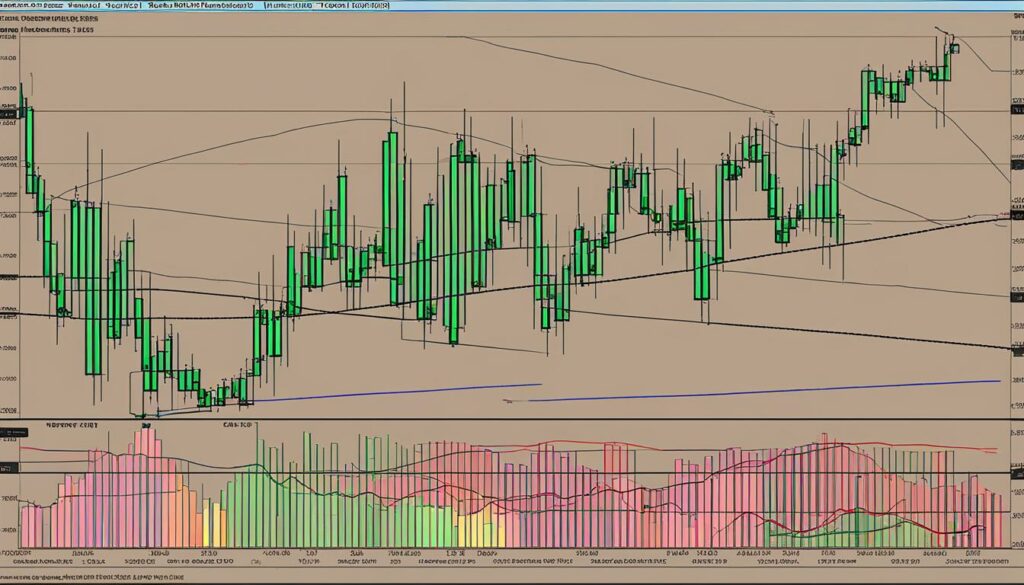Stochastic Indicator Maestro: Technical Analysis With The Oscillator

Welcome to our comprehensive guide on the Stochastic Oscillator, a powerful tool used by traders worldwide to evaluate market momentum and identify potential trading opportunities. Developed by George C. Lane in the 1950s, the Stochastic Oscillator has become an essential component of technical analysis, helping traders make more informed decisions and improve their trading strategies.
In this article, we will dive deep into the workings of the Stochastic Oscillator, uncovering its formula, analyzing its importance in identifying overbought and oversold markets, exploring various trading strategies, and understanding how it can complement other technical analysis tools. We will also address the limitations of relying solely on the Stochastic Oscillator for trading decisions and provide key insights into interpreting and analyzing its data.
Key Takeaways:
- The Stochastic Oscillator compares the closing price to the range of prices over a specific period, providing valuable insights into market momentum.
- Traders can utilize various strategies with the Stochastic Oscillator, such as identifying overbought and oversold conditions or recognizing divergences for potential trading opportunities.
- It is essential to use the Stochastic Oscillator in conjunction with other technical analysis tools to confirm signals and consider market conditions.
- While the Stochastic Oscillator is a powerful tool, it may generate false signals during range-bound markets or periods of high volatility, highlighting the need for comprehensive analysis.
- When analyzing data from the Stochastic Oscillator, pay attention to the %K and %D lines, crossovers, and readings in the overbought and oversold areas.
Understanding the Stochastic Oscillator Indicator
The Stochastic Oscillator is a popular technical analysis tool used by traders to evaluate market momentum and identify potential trend changes. By understanding the formula behind the indicator and how it works, traders can make more informed trading decisions.
The Stochastic Oscillator compares the closing price of an asset to the range of prices over a specific period of time. It calculates two lines called %K and %D. The %K line represents the current closing price’s position relative to the range, while the %D line is a moving average of the %K line. These lines intersect and generate trading signals that traders can use to identify potential entry and exit points.
The formula behind the Stochastic Oscillator indicator involves applying a simple moving average to the %K line. This moving average smooths out the %K line’s fluctuations, providing a more accurate representation of market momentum. Traders can use the indicator’s readings and crossovers between the %K and %D lines to gain insights into the market’s strength and potential trend reversals.
Example Table: Stochastic Oscillator Readings
| Date | Close Price | %K | %D |
|---|---|---|---|
| 2021-01-01 | 100 | 80 | 75 |
| 2021-01-02 | 110 | 90 | 85 |
| 2021-01-03 | 95 | 60 | 77 |
| 2021-01-04 | 105 | 75 | 78 |
The table above showcases sample Stochastic Oscillator readings for a hypothetical asset over a series of dates. Traders can analyze the %K and %D values to identify potential trading opportunities. For instance, when the %K line crosses above the %D line, it may indicate a buy signal. Conversely, a crossover where the %K line falls below the %D line could suggest a sell signal.
By incorporating the Stochastic Oscillator indicator into their technical analysis toolkit, traders can gain valuable insights into market momentum and potential trend reversals. However, it’s important to remember that the indicator should be used in conjunction with other analysis techniques and market context to make well-rounded trading decisions.
Importance of Momentum in the Stochastic Oscillator
The Stochastic Oscillator is a widely used technical indicator that measures momentum in the market. It plays a crucial role in helping traders identify potential trend changes and make informed trading decisions. By understanding the importance of momentum in the Stochastic Oscillator, traders can gain valuable insights into market dynamics and improve their trading strategies.
Momentum refers to the strength and speed of price movements in a given direction. The Stochastic Oscillator calculates momentum by comparing the closing price to a price range over a specific time period. It provides traders with valuable information about the pace at which the market is moving and whether it is overbought or oversold. This way, this indicator can also be used for options momentum strategies.
Knowing the direction and strength of momentum is essential for traders because it can signal potential trend reversals. When the market’s momentum is slowing down, it may indicate that a trend is losing steam and a reversal could be on the horizon. On the other hand, when momentum is strong and accelerating, it suggests that a trend is gaining strength, and traders may want to consider riding the trend.
By monitoring momentum with the Stochastic Oscillator, traders can identify trading opportunities based on the direction of momentum. For example, if the market is in an uptrend and the Stochastic Oscillator shows that momentum is strengthening, it may be a good time to enter a long position. Conversely, if the market is in a downtrend and the Stochastic Oscillator indicates that momentum is weakening, it may be a signal to consider shorting the market.

Table: Summary of Strategies to Use the Stochastic Oscillator in Trading
| Strategy | Description |
|---|---|
| Overbought/Oversold Signals | Utilize signals when the indicator crosses into the overbought or oversold areas to identify potential trend reversals. |
| Trend Confirmation | Consider the larger timeframe trend and trade in alignment with it to increase the probability of success. |
| Divergences | Look for divergences between price and the Stochastic Oscillator, such as bullish or bearish divergences, to identify potential trend changes. |
| Crossovers | Use crossovers between the %K and %D lines as potential entry and exit signals for trading opportunities. |
- Overbought/Oversold Signals: Utilize signals when the indicator crosses into the overbought or oversold areas to identify potential trend reversals.
- Trend Confirmation: Consider the larger timeframe trend and trade in alignment with it to increase the probability of success.
- Divergences: Look for divergences between price and the Stochastic Oscillator, such as bullish or bearish divergences, to identify potential trend changes.
- Crossovers: Use crossovers between the %K and %D lines as potential entry and exit signals for trading opportunities.
“The Stochastic Oscillator offers various strategies to optimize trading decisions. By incorporating overbought and oversold signals, trend confirmations, divergences, and crossovers, traders can enhance their trading strategies and improve their chances of success.” – Professional Trader
Identifying Overbought and Oversold Markets
The Stochastic Oscillator is a valuable tool for traders to identify overbought and oversold markets. By understanding these market conditions, traders can make informed decisions on potential trend reversals and anticipate profitable trading opportunities.
When the Stochastic Oscillator reading is above 80, it suggests that the market is overbought, indicating a potential reversal in price. Traders may consider this as an opportunity to sell or take profit on an existing position. Conversely, when the reading is below 20, it indicates that the market is oversold, signaling a potential bounce back in price. Traders may consider this as an opportunity to buy or enter a long position.

By incorporating the recognition of divergences into their trading arsenal, traders can gain a deeper understanding of market dynamics and increase the likelihood of success. However, it’s important to note that divergences should not be the sole basis for trading decisions. Traders should consider other technical indicators, market conditions, and risk management strategies to ensure a well-rounded approach to trading. Divergences, when used in conjunction with other tools, can offer valuable confirmation and enhance the overall effectiveness of trading strategies.
Utilizing Crossovers for Potential Entries and Exits
When it comes to trading with the Stochastic Oscillator indicator, one valuable technique is to utilize crossovers for potential entries and exits. Crossovers occur when the %K line crosses the %D line on the Stochastic Oscillator, and they can provide important signals for traders looking to enter or exit positions.
A bullish crossover happens when the fast %K line crosses above the slow %D line. This can be seen as a buy signal, suggesting that the price may be poised for an upward move. On the other hand, a bearish crossover occurs when the fast %K line crosses below the slow %D line, indicating a potential sell signal and a possible downward price movement.
By paying attention to these crossovers, traders can identify opportunities to enter or exit trades based on the direction of the crossover and the prevailing market conditions. However, it’s important to note that crossovers alone may not be enough to make trading decisions. They should be used in conjunction with other technical analysis tools and factors such as trend confirmations and market context to increase the probability of successful trades.
Overall, utilizing crossovers as potential entry and exit signals can be a valuable technique when trading with the Stochastic Oscillator indicator. Traders should consider the specific crossover type (bullish or bearish), along with other factors, to make well-informed trading decisions and enhance their overall strategies.
Example Table: Historical Crossover Data
| Date | Crossover Type | Action |
|---|---|---|
| January 1, 2022 | Bullish | Buy |
| March 15, 2022 | Bearish | Sell |
| May 20, 2022 | Bullish | Buy |
| July 10, 2022 | Bearish | Sell |
The table above presents a hypothetical historical crossover data for illustration purposes. Traders can use this type of data, along with other analysis, to inform their decision-making process when utilizing crossovers with the Stochastic Oscillator indicator.

Common Strategies for Using the Stochastic Oscillator Indicator
When it comes to utilizing the Stochastic Oscillator indicator in trading, there are several common strategies that traders can employ. These strategies can help traders identify potential trading opportunities and make more informed decisions in the market. Let’s take a closer look at some of these strategies:
1. Trading Overbought and Oversold Conditions
One of the most popular strategies with the Stochastic Oscillator is to trade overbought and oversold conditions. When the indicator reaches the overbought level (above 80), it suggests that the market may be due for a reversal or pullback. On the other hand, when the indicator reaches the oversold level (below 20), it indicates that the market may be ripe for a bounce back. Traders can use these levels as potential entry or exit points, depending on their trading strategy and risk tolerance.
2. Following Trend Confirmations
Another strategy is to use the Stochastic Oscillator to confirm trends in the market. Traders can look for situations where the indicator aligns with the overall trend on a larger timeframe. For example, if the market is in an uptrend, traders can look for bullish crossovers on the Stochastic Oscillator (fast %K line crossing above slow %D line) as potential buy signals. Similarly, in a downtrend, bearish crossovers (fast %K line crossing below slow %D line) can be used as potential sell signals.
3. Looking for Divergences
Divergences can also provide valuable trading opportunities when using the Stochastic Oscillator. Divergences occur when the price and the Stochastic Oscillator are moving in opposite directions. Traders can look for bullish divergences (price makes a lower low, but the Stochastic makes a higher low) or bearish divergences (price makes a higher high, but the Stochastic makes a lower high) to identify potential trend reversals or continuations. Divergences can act as a confirmation signal when combined with other technical analysis tools and market context.
By incorporating these common strategies into their trading approach, traders can take advantage of the Stochastic Oscillator indicator’s potential to generate trade signals and enhance their overall trading strategy. It is important for traders to determine which strategies align with their individual trading style and risk management techniques, and to adapt them accordingly.
Limitations of Relying Solely on the Stochastic Oscillator Indicator
While the Stochastic Oscillator is a useful tool for technical analysis, it is important to understand its limitations when making trading decisions. Relying solely on the Stochastic Oscillator without considering other factors can lead to potential drawbacks and false signals.
One limitation of the Stochastic Oscillator is its performance during range-bound markets. In a sideways market with little price movement, the indicator may generate numerous crossover signals that can be misleading. Traders should be cautious when using the Stochastic Oscillator in such market conditions and consider other indicators or strategies to confirm signals.
Another limitation is the indicator’s sensitivity to market volatility. During periods of high volatility, the Stochastic Oscillator may produce erratic readings, leading to false signals. Traders should be aware of market conditions and adjust their trading strategies accordingly, using the Stochastic Oscillator in conjunction with other tools to filter out noise and false signals.
It is also important to note that the Stochastic Oscillator is not a standalone indicator. It should be used in conjunction with other technical analysis tools and considerations, such as trend lines, support and resistance levels, and fundamental analysis. By combining multiple indicators and factors, traders can gain a more comprehensive understanding of the market and make better-informed trading decisions.
Table: Limitations of Relying Solely on the Stochastic Oscillator Indicator
| Limitations | Explanation |
|---|---|
| Range-bound markets | Generates numerous crossover signals that can be misleading |
| High volatility | Produces erratic readings and false signals during periods of market turbulence |
| Not a standalone indicator | Should be used in conjunction with other technical analysis tools and considerations |
In conclusion, while the Stochastic Oscillator can be a valuable tool in technical analysis, it is important to recognize its limitations. Traders should exercise caution, consider market conditions, and use the indicator in conjunction with other tools to make well-rounded trading decisions.
Interpreting and Analyzing Data from the Stochastic Oscillator Indicator
When it comes to effectively interpreting and analyzing the data provided by the stochastic oscillator indicator, there are a few key components to consider. These components will help us make informed trading decisions and gain valuable insights into market momentum. Let’s explore them further:
1. %K and %D Lines
The stochastic oscillator indicator generates two lines, %K and %D, which are critical in understanding market momentum. The %K line represents the current closing price in relation to the high-low range over a specific period. The %D line is a moving average of the %K line and helps smooth out volatility. By observing the interactions between these lines, traders can identify potential buying or selling opportunities.
2. Crossovers
Crossovers occur when the %K line crosses the %D line on the stochastic oscillator. These crossovers can serve as entry and exit signals. A bullish crossover, where the %K line crosses above the %D line, may suggest a buy signal. Conversely, a bearish crossover, where the %K line crosses below the %D line, may indicate a sell signal. Traders can use these crossovers in conjunction with other technical analysis tools to confirm trends and make timely trading decisions.
3. Overbought and Oversold Levels
The stochastic oscillator indicator also helps identify overbought and oversold market conditions. When the indicator reaches or exceeds the 80 level, it suggests that the market may be overbought and due for a potential reversal. Conversely, when the indicator falls or reaches the 20 level, it indicates that the market may be oversold and could experience a bounce back. Traders can use these levels to determine when a trend may be reaching its extreme and consider potential reversals or corrections.
By effectively interpreting and analyzing the data provided by the stochastic oscillator indicator, we can gain valuable insights into market momentum and make more informed trading decisions. The %K and %D lines, crossovers, and overbought and oversold levels are key components to consider. However, it’s important to remember that the stochastic oscillator should be used in conjunction with other technical analysis tools and market conditions for a well-rounded trading strategy.

| Key Components | Description |
|---|---|
| %K and %D Lines | The %K line represents the current closing price in relation to the high-low range, while the %D line is a moving average of the %K line. |
| Crossovers | Crossovers occur when the %K line crosses the %D line and can serve as entry and exit signals. |
| Overbought and Oversold Levels | These levels indicate when the market may be reaching extreme conditions, suggesting potential reversals or corrections. |
Conclusion
In conclusion, the Stochastic Oscillator is a powerful technical analysis tool that can greatly enhance a trader’s ability to evaluate market momentum and identify potential trading opportunities. Developed by George C. Lane in the 1950s, this widely used indicator compares the closing price to a specific price range over a certain period of time. By generating %K and %D lines, it provides valuable insights into market conditions and potential trend changes.
Traders can utilize the Stochastic Oscillator in various strategies to improve their trading performance. Some common approaches include utilizing overbought and oversold conditions, following trend confirmations, and recognizing divergences for potential trading opportunities. Additionally, crossovers between the %K and %D lines can serve as entry and exit signals.
However, it’s important to note that while the Stochastic Oscillator is a valuable tool, it should not be relied upon as the sole basis for trading decisions. It is crucial to use it in conjunction with other technical analysis tools and consider market conditions to make well-rounded and informed trading choices.
In summary, the Stochastic Oscillator is a key component of any trader’s toolkit. By understanding how it works and incorporating it into a comprehensive trading strategy, traders can gain deeper insights into market momentum and increase their chances of success in the markets.
FAQ
What is the Stochastic indicator?
The Stochastic indicator is a technical analysis tool developed by George C. Lane in the 1950s. It evaluates market momentum by comparing the closing price to a price over a specific period of time. Traders use it to identify overbought and oversold markets, signaling potential trend changes.
How does the Stochastic Oscillator work?
The Stochastic Oscillator compares the closing price to the range of prices over a certain period of time. It calculates the %K and %D lines, which intersect to provide trading signals. Traders can use the indicator by understanding how these lines and signals are generated.
What does the Stochastic Oscillator measure?
The Stochastic Oscillator measures momentum in the market. It shows when the market’s momentum is slowing down, which can signal a potential change in trend. Traders can use this information to identify trading opportunities and make informed decisions based on the direction of momentum.
What are some strategies to use with the Stochastic Oscillator?
Traders can use several strategies with the Stochastic Oscillator. One common strategy is to use the signals generated when the indicator crosses in the overbought or oversold areas. Another strategy is to take into account the trend on a larger timeframe and trade in line with it. Traders can also look for divergences and utilize crossovers for potential entries and exits.
How does the Stochastic Oscillator help identify overbought and oversold markets?
When the indicator is above 80, it suggests that the market is overbought and may be due for a reversal. Conversely, when the indicator is below 20, it indicates that the market is oversold and may be ripe for a bounce back.
What are divergences and how can they be used with the Stochastic Oscillator?
Divergences occur when the price and the Stochastic Oscillator are moving in opposite directions. Bullish divergences (price makes a lower low, but the Stochastic makes a higher low) or bearish divergences (price makes a higher high, but the Stochastic makes a lower high) can signal potential trend reversals or continuations.
How can crossovers be utilized with the Stochastic Oscillator?
Crossovers occur when the %K line crosses the %D line on the Stochastic Oscillator. Traders can use these crossovers as potential entry and exit signals. A bullish crossover (fast %K line crosses above slow %D line) may indicate a buy signal, while a bearish crossover (fast %K line crosses below slow %D line) may indicate a sell signal.
How can the Stochastic Oscillator complement other trading tools?
The Stochastic Oscillator can be used in conjunction with other technical analysis tools such as moving averages, trend lines, and other indicators. It can confirm signals or provide additional insights to enhance trading strategies.
What are some common strategies for using the Stochastic Oscillator indicator?
Common strategies include trading overbought and oversold conditions, following trend confirmations, and looking for divergences. Traders can combine these strategies with their own analysis and risk management techniques to develop a personalized trading approach.
Are there any limitations or drawbacks to relying solely on the Stochastic Oscillator indicator for trading decisions?
Yes, the Stochastic Oscillator may generate false signals during range-bound markets or periods of high volatility. It should be used in conjunction with other technical analysis tools and traders should consider market conditions to make well-rounded trading decisions.
How can I effectively interpret and analyze the data provided by the Stochastic Oscillator indicator?
Traders should pay attention to the %K and %D lines, crossovers, and readings in the overbought and oversold areas. The key components of a Stochastic Oscillator reading include the current value of %K, %D, and the position of the lines in relation to the overbought and oversold levels.





